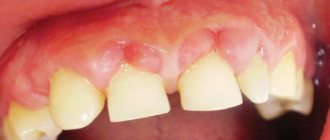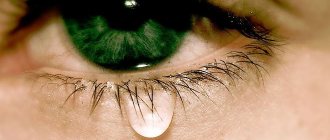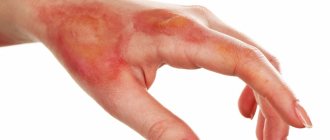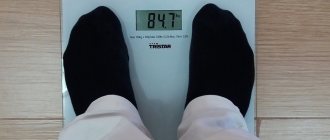What is hypermetropia?
Hypermetropia is a vision pathology in which it is difficult for a person to recognize nearby objects, but at the same time he can see well into the distance. With this disorder, image formation occurs not on the retina, but behind it.
Mild hypermetropia in a preschool child in most cases is a variant of the norm. As the baby develops and grows, the ability to see normally is restored.
Mild hypermetropia and concomitant diseases
The organs of vision require careful treatment and special control. Even mild hypermetropia can be accompanied by serious illnesses that will reduce the ability to see fully both for a while and for the rest of your life if the problem is ignored.
- Strabismus is especially common in children who have a positive vision value of more than 3. This is caused by the fact that the baby constantly has to move his eyes towards the bridge of his nose in order to achieve greater clarity.
- Amblyopia, or “lazy eye syndrome,” is based on a disorder of binocular vision. This disease is characterized by the inactivity of one eye in the process of vision. Strabismus often develops into amblyopia due to the fact that the squinting eye is not involved in the work. Mostly children suffer from this disease, so it is important to diagnose and correct “lazy eye syndrome” as early as possible.
- Glaucoma occurs as a result of constant eye pressure. Hypermetropia is one of the diseases leading to this pathology.
- Mild hypermetropia with astigmatism is characterized by a violation of the shape of the lens or cornea, which is why a person sees a blurred, double image. In this case, visibility deteriorates as the object approaches the eyes.
Until what age is childhood farsightedness considered normal?
As a rule, a visual defect is detected in a child at the age of 5-7 years, when educational activities begin and the child prepares for school. But almost all newborns have this disorder, since the visual apparatus is just beginning to form. And only after 3-4 years the condition stabilizes.
Mild hypermetropia should disappear before the age of 10-12, as the child’s eyeball gradually enlarges, resulting in a shift of the optical focus to the retina. If symptoms of the disorder are still present, treatment must be started, otherwise severe complications may develop.
Classification of degrees
There are 3 degrees of farsightedness:
- weak – visual deviation +2 diopters;
- average – from +2 to +4-5 diopters;
- high – above +5 diopters.
Mild hypermetropia may not be clinically apparent. Typically, pathology begins to develop at a young age. Blurred vision is often corrected by increased work of the eye muscles. They, in turn, use excessive tension to “push” the focus point to the desired place – the retina. Therefore, for a long time people do not experience vision problems. The only concerns are headache, dizziness or eye fatigue.
These symptoms do not always occur together. And the person does not pay due attention to them, taking temporary measures such as pain relief. This delays visiting a doctor and timely vision correction. Farsightedness, meanwhile, becomes more severe.
In moderate cases, eye symptoms come to the fore: blurred vision, blurred images near, lacrimation, burning eyes. Deterioration of vision is accompanied by headache, dizziness, signs of astigmatism and strabismus begin to develop.
Causes of visual pathology
The causes of childhood farsightedness are different.
The disorder may occur as a result of:
- anatomical pathologies of the structure of the organs of vision. The defect may occur due to congenital anomalies, for example, irregular shape or recessed position of the lens, insufficient curvature of the cornea, shortened ocular axis;
- hereditary predisposition. The occurrence of pathology is provoked by high loads on the organs of vision. Impairments become especially noticeable in school-age children who are beginning to read and write;
- increased intraocular pressure. In this case, the pathology is diagnosed in infants;
- unbalanced nutrition and bad habits of a woman during pregnancy, which causes improper formation of the fetal visual system;
- incorrect selection of optical vision correction means;
- eye injuries (impacts, burns);
- surgical interventions on the eyes;
- complications of inflammatory pathologies.
Eye exercises
An interesting exercise when reading or writing for a long time is solarization. In order for the eyes to relax and rest, they must be directed to the sun or a candle. Vision should be focused on the light source and slowly turn your head in different directions. The duration of the exercise is 10 minutes. You should not use bright sun in this case.
Excessive eye fatigue with farsightedness is accompanied by asthenic manifestations. Children experience fatigue, irritability, and headaches. This affects problems in the educational process. Timely diagnosis will help avoid more serious complications.
It is necessary to do standard exercises periodically. In this case, the eyes move up, down, left, right. The duration of the procedure is 5-7 minutes. It is also useful to make circular turns of the neck and head.
Symptoms
Mild hypermetropia in a child is accompanied by the following symptoms:
- rapid eye fatigue, dryness and redness, lacrimation;
- dizziness;
- headaches.
Moderate pathology may be accompanied by inflammatory processes in the organs of vision (blepharitis, conjunctivitis), sleep disturbances, and problems with the nervous system. The child suffers from pain in the area of the bridge of the nose and brow ridges, and the eyes quickly get tired during work.
With a severe degree of the disease, the baby has difficulty seeing not only near, but also distant objects, he becomes nervous and withdrawn.
Which doctor treats moderate hypermetropia?
Ophthalmologists deal with visual impairments. You should contact them for headaches of unknown origin, doubling of objects, or flickering of spots before the eyes.
A decrease in visual ability is observed in diabetes mellitus, which is associated with damage to the body’s vascular system. In case of poor vision, it is necessary to determine the level of glucose in the blood and consult an endocrinologist.
Arterial hypertension also contributes to decreased vision. A visit to a therapist is necessary to prescribe medications that reduce general blood pressure.
Classification of childhood hypermetropia
In terms of severity, farsightedness can be:
- weak – up to 2 D;
- medium – 2-5 D;
- high – more than 5 D.
Weak degree
Mild hypermetropia in a child is generally a temporary phenomenon and is not considered a pathology. As the baby develops, the eye muscles become stronger and vision normalizes. Pronounced manifestations may not occur; the child does not notice the disturbances and sees both close and distant objects well.
Average degree
Average degree of farsightedness develops if the signs of the initial stage were ignored.
In this case, the disturbances are more noticeable - the child has to move away from himself the objects that he wants to look at, he needs brighter lighting while reading or writing.
High degree
When the impairment is high, the patient is unable to see regardless of distance. The child is forced to wear corrective glasses; without them he cannot see anything. There is a feeling of sand in the eyes, and there is frequent and severe headache.
Hypermetropia
Human eyes are very sensitive to various changes, which leads to loss of visual acuity. Often a person cannot distinguish between objects either near or far away. This is conventionally called farsightedness and myopia. Farsightedness, also known as hypermetropia, is characterized by clear vision of objects in the distance, but at close range the patient’s image is blurry. Why is this happening? It turns out that the clarity of the image is formed using the lens, and the place where the beam is refracted is the retina. It's in good condition. With farsightedness, the eye flattens slightly, causing rays to focus behind the retina. In a word, the focal length of the lens becomes larger than it should be, but the curvature, on the contrary, becomes smaller.
Main forms of the disease and symptoms
Hypermetropia is classified according to severity as follows:
- Mild hypermetropia of both eyes or one organ manifests itself sluggishly, so the patient practically does not complain about changes in acuity in everyday life. Only when working with small objects does it become difficult for him to see. For example, he cannot thread a needle without difficulty or finds it difficult to read small print. Mild hypermetropia: what is it and what other symptoms are there? Of course, for this degree it is very important to pay attention to the signs so that pathology can be detected in a timely manner. In addition to the above symptoms, the patient has a headache and blurred objects. In addition, it is difficult for him to concentrate and focus his eyes on one image. For a clear vision, a person has to make an effort and several seconds must pass. Contact lenses or glasses from 2.5 to 3 diopters are prescribed as a corrective agent.
- Moderate hypermetropia is characterized by a blurred image of all objects located near the eyes. In order to look at a book, for example, the patient has to move it away to arm's length. But the vision into the distance still remains. For vision correction, glasses are used: +5-5.5 diopters.
- High degree hypermetropia differs significantly from moderate and weak hypermetropia, since at this stage there is a deterioration in visual acuity at a greater distance. Of course, a person sees objects located very far away clearly. This is due to the fact that the ability to bend the lens with muscles (accommodation) is exhausted. If in the first 2 cases wearing glasses can be periodic, that is, only when working with objects nearby, then in this case this is impossible. Therefore, a person must wear glasses all the time. The lenses have more than 5 diopters.
ATTENTION! People often ask the same question: what is hypermetropia of the 1st degree, 2nd and 3rd. The fact is that it is easy to distinguish a weak stage from a high one, but it is difficult to understand what the stage is by numbers. In fact, stage 1 is a weak stage, stage 2 is medium and, accordingly, stage 3 is high.
Causes of farsightedness
Hypermetropia of the eye occurs when the eyeball is too short, the cornea is flat, and accommodation is impaired. But the circumstances leading to such a change may be as follows:
- The age of a person is after 40 years. The fact is that over the course of life, all human organs wear out, especially vision. Because a person reads quite a lot, works at a computer, watches TV and generally strains his eyes. This type of farsightedness is called presbyopia.
- The hereditary factor plays a huge role, since hypermetropia is often transmitted at the genetic level. And it should be especially noted that children whose both parents have farsightedness are at risk.
- Eye injury from impact, fall, etc.
- Pathological changes in the retina in diabetes mellitus.
- Microphthalmia, that is, small eye organ syndrome. As a rule, pathology develops inside the mother's womb.
- Foveal hypoplasia. In this case, there are problems with the blood supply to the retina.
Farsightedness in childhood
Today, farsightedness in childhood is more common than in previous times. Therefore, the question, hypermetropia in children: what is it, is very relevant. Every parent should know the primary symptoms of the disease in order to contact a pediatric ophthalmologist in a timely manner. But why does farsightedness so often affect children? It turns out that this is influenced not only by heredity and pathological disorders inside the womb, but also by the fact that the child is constantly growing. Consequently, the size of the eyeball changes periodically. Sometimes the size of the eye elements increases unevenly, but over time everything returns to normal. In this case, hypermetropia goes away on its own by about 14 years of age.
IMPORTANT! Not in all cases the child outgrows farsightedness, so it is imperative for parents to pay attention to the child’s behavior. If he squints his eyes when examining an object up close, go to the doctor immediately!
Farsightedness in children is characterized in the same way as in adults: it has the same severity and symptoms. It is very important to buy plus glasses in a timely manner, since without them the child will subject his eyes to unnecessary stress. And this leads to the development of concomitant diseases. As a result, the child will develop new eye diseases.
Diagnosis of hypermetropia (farsightedness)
In order to diagnose farsightedness, you need to contact an ophthalmologist, who will first determine visual acuity from different distances (visometry). After this the following is assigned:
- The perimetry of both eyes determines the field of vision, which makes it possible to identify the location of the pathology. This method has a high degree of reliability.
- Skiascopy allows you to examine refractions using an ophthalmoscope and rulers. In this case, the nature of the movement of the shadow in the pupil is studied.
- Refractometry determines refractive power.
- Ophthalmoscopy reveals concomitant diseases.
- Viewed through a Goldmann lens.
- An ultrasound examination examines the front and rear axles.
Conservative methods of treating hypermetropia
Treatment of eye hyperopia is carried out at an individual level, depending on the severity of the pathology. First of all, the doctor will prescribe correction using glasses or contact lenses, which are selected taking into account the degree of the disease:
- Spectacle correction is considered the most common and inexpensive. With weak and moderate degrees, they need to be worn only when the patient is doing something (reading, cleaning, writing, etc.). But at a high degree, wearing should be constant. Despite all the advantages of glasses, they also have many disadvantages. Firstly, this is the aesthetic side, and secondly, glasses cause a lot of inconvenience. Namely: they fall and slide during operation, quickly fog up, dust and dirt settle on them. Therefore, they are inconvenient for work with active physical labor and for playing sports. But this is not the most important thing. It turns out that glasses are not capable of providing 100% correction. The fact is that in this case, lateral vision is limited, therefore, spatial perception and the stereoscopy effect are impaired.
- Contact lenses are also in demand, but their cost is much higher than the price of glasses. In addition, they need to be periodically replaced with new ones. The disadvantages include long-term addiction to lenses and the risk of contracting infectious diseases. But this is in case of improper storage and putting on. Therefore, it is very important to comply with hygiene requirements. Unlike glasses, lenses quite often (especially at first) cause allergies, resulting in redness of the eyes. But contact lenses do not interfere with lateral vision and an active form of life. They never fall out or break, do not fog up or collect dust.
Drug therapy
Unfortunately, there are no drugs that change refractive power or correct accommodation. However, with farsightedness, a necessary condition is the improvement of all metabolic processes and nutrition of the eye. Vitamin therapy is used for this. Vitamin A is mainly used, as it helps stop the progression of eye diseases, improve sharpness and nourish eye tissue. Vitamin B activates metabolic processes, and vitamin C suppresses toxins released after cell metabolism. The following eye drops are actively used today:
- "Okovit."
- "Focus".
- "Vitaiodurol".
- "Visiomax".
- "Ophthalmologist."
- "Mirtilene forte."
- "Taufon".
If you wear contact lenses, you will also need Visine. These drops quickly and effectively relieve irritation, swelling and any inflammatory process. To prevent your eyes from drying out, moisturizing drops such as Roto Vita and Sante are used. In addition to medications, the doctor also prescribes hardware therapy. This could be an “Amblyocor”, “Synoptophore” or “Amblyotrener” device.
Surgical methods
To fully treat eye hyperopia, surgical intervention is used. Today there are many cutting-edge, effective and safe methods:
- Keratotomy, in which deep incisions are made.
- Thermocoagulation: the doctor applies pinpoint coagulants with a laser.
- Hypermetropic autokeratoplasty: the surgeon inserts an implant (autobiolens) under the surface of the cornea.
- Keratomileusis is the cutting off of certain areas of the cornea with a laser.
- Photorefractive keratectomy.
Diagnosis and treatment features
It is difficult to diagnose the disease in children 1-4 years old, since children are not yet able to formulate their complaints. After 5-6 years it is easier to identify the problem. In preschool children, due to increased loads on the visual organs, farsightedness begins to develop rapidly.
Before the examination, the specialist puts drops into the child’s eyes that dilate the pupil. As a result, the ciliary muscle relaxes, which makes it possible to correctly measure the light refractive ability of the eye.
In preschool children
To identify a problem in a preschooler, the doctor collects an anamnesis. Since the baby is not yet able to describe the signs, parents must provide full information regarding his well-being.
For preschool children, tables with pictures are used. From 2-3 years of age, the study is carried out using the Orlova table. It depicts objects that are familiar to children, so they can easily name them.
This check can be carried out at home, for this you need:
- Print the table in A4 format.
- Place it at the level of the baby's head at a distance of 2.5 m in a well-lit place.
- Check one eye of the child, offering to close the other with your palm. Repeat for the other eye. Before testing, it is advisable to show the table to the child and ask him to name the images. This will make it easier for him to understand what needs to be done, and his parents will understand what he calls each object.
It is important to take into account that a small child gets tired quickly. First, you need to show your baby one image at a time from the top row of the table, moving down. If the picture is named incorrectly, you should ask to name other objects in this row, then move to the top line and continue until the child names all the pictures.
But this technique is not always effective, especially with a weak degree of hypermetropia. Therefore, other methods can be used, for example, ophthalmoscopy. A specialist uses a special device to examine the fundus of the eye to identify abnormalities.
It is also possible to use:
- autorefractometry - a method that allows you to determine violations of the refractive power of the eye;
- gonoscopy, which examines the anterior chamber of the eyeball;
- skiascopy, which determines the refraction of the eye.
If the diagnosis is confirmed, drastic methods of treatment are not used.
In case of a high degree of violation, the use of hardware techniques is recommended:
- ultrasound therapy;
- vacuum massage;
- electrical stimulation;
- magnetic therapy;
- laser therapy.
These procedures are painless and are carried out approximately 2 times every six months. The use of optical correction products is also recommended. In addition, parents should ensure that the baby eats well, receiving all the necessary vitamins and minerals. You can use dietary supplements that accelerate the development of visual organs and improve metabolic processes.
In school-age children
Diagnosis of school-age children is carried out using the same methods as for preschoolers. However, in this case, you can already use the traditional Sivtsev table, since the child already distinguishes letters and can name them.
The development of visual impairment in children of this age is often caused by excessive loads that provoke spasm of the visual muscle. The specialist may recommend the use of glasses or contact lenses.
The use of hardware techniques and vitamin therapy is effective. Laser vision correction may be recommended after 16 years of age. Microsurgical intervention is indicated only in severe cases, if farsightedness is pronounced.
Diagnosis of the disease
In ophthalmology, mild hypermetropia can be easily determined by an experienced doctor, even with a routine visual acuity test. To clarify the diagnosis, ophthalmologists use many diagnostic methods.
- Visometry is one of the main ways to identify visual acuity indicators. It is carried out using a table and trial lenses. The table consists of a dozen letters, the font of which decreases with each line.
- Skiascopy is a procedure aimed at assessing the state of refraction of the eyes. This procedure is also called “shadow test”, since the study using a skiascope takes place in a semi-dark room. Using a two-way mirror, the optometrist shines a beam of light into the patient's eye and observes the patient's reflexes. By rotating the instrument around its axis, it draws conclusions based on the movements of the shadow.
- Computer refractometry is a study of refractive ability using special computer refractometers. The advantage of computer research is that the analysis of light reflected from the retina is carried out automatically.
To clarify the diagnosis, doctors often prescribe additional tests:
- Ultrasound - shows the true picture of the condition of the eye tissues and the fundus of the eye, allows you to see disturbances in the structure of the visual organs.
- MRI - this diagnostic method displays the entire structure of the eye, assesses the condition of the fundus and optic nerves.
- Fluorescein angiography of the visual organs is a method for studying the vessels and capillaries of the retina.
Eyes susceptible to hypermetropia may also have concomitant diseases. To determine these pathologies, additional research methods are used.
- Perimetry - determination of visual fields, this is necessary to assess the condition of the optic nerve and retina, to monitor the development of pathologies.
- Ophthalmoscopy - this procedure allows the ophthalmologist to assess the condition of the retina, eye vessels, and determine pathologies.
- Biomicroscopy - using a slit lamp, you can diagnose various pathologies, determine changes in the choroid of the eyes, optic nerve, and retina.
- Tonometry - this test allows you to measure intraocular pressure using a tonometer. This check is relevant if glaucoma is suspected and the development of the eyeball is impaired.
- Biometric examination of the eye - this diagnostic method is used for incipient strabismus.
As a rule, during the examination, special drops are instilled into the eye, causing the pupil to dilate. This gives the specialist the opportunity to determine low-grade latent hypermetropia.
Treatment options
Until 16-18 years of age, hypermetropia therapy is carried out using conservative methods. If there is no positive effect, after reaching adulthood the issue of laser treatment or microsurgery is decided.
Optical correction
The main method of vision correction is wearing glasses. Moderate and severe impairment requires their constant use. However, it is important to choose them correctly, otherwise your vision will only worsen. Timely therapy helps to completely solve problems in most cases.
Mild hypermetropia in a child does not require constant use of optical correction. Glasses should be used while reading, writing, or watching TV. This temporary correction is enough to stabilize vision.
Mild hypermetropia is treated by wearing glasses
Glass therapy has its drawbacks. The vision correction product interferes with physical activity and can slip and get dirty. An alternative option is to use contact lenses. They should also be selected by a specialist. It is better to give preference to products from well-known manufacturers (for example, Vision, Hydro).
Hardware methods
Hardware techniques are recommended if hypermetropia is combined with:
- asthenopia (visual fatigue);
- decreased visual acuity;
- squint;
- lazy eye syndrome.
When using hardware techniques:
- microcirculation in tissues improves;
- hemodynamics increases;
- metabolic processes are accelerated;
- trophic processes are optimized.
Therapy takes place in a playful way. Changes in the size and color of an object, bright flashes contribute to the activation of retinal receptors.
Therapy methods:
| Name | The essence of the method |
| Crosses | In front of the child there is a multi-colored chessboard on which the circle must be moved. At the same time, the size and color of the cells change. This game helps stimulate the neurons of the visual analyzer. |
| Spider | The child is encouraged to look at the spiral and radial lattices intertwining and changing color. Thanks to this process, the retinal field receptors are activated. The use of backgrounds of different colors allows you to influence light and dark channels. |
| Relief | The method is based on the use of images with sharp changes in light and shadow. Recommended for lazy eye syndrome. |
| Circuit | The child needs to complete some images. In the process, a dosed load is created on the eyes, which helps to increase visual acuity. |
| Flower | During the game, you need to find a certain symbol among the others, drawn on a flower petal. |
Children like such multimedia games. They have been used since 3 years. Thanks to computer technology, therapy parameters can be adjusted to the child’s intelligence level.
Special exercises for the eyes
At an early stage of the development of the disease, therapeutic exercises can be effective. You need to exercise every day. Exercise strengthens the eye muscles and improves blood supply to the visual organs. You can perform it in any convenient place and at any time, but always before meals.
A set of exercises for the eyes (starting position – sitting on a chair):
- Follow alternately the circular movements of the fingers of your right hand, then your left hand, while keeping your head straight.
- Concentrate your gaze on a distant object, and then on a nearby one.
- Turn your head to the right and left, while moving your gaze.
- Place your hands on the back of your head, bend your back, placing your feet on your toes. After this, relax by lowering your arms and stretching your legs.
- Describe circles with your eyes, make horizontal and vertical movements.
Vacuum massage
An effective procedure is vacuum massage. It is carried out using a special apparatus, similar to ordinary glasses.
The device, gently affecting the area around the eyes, has a positive effect:
- improves metabolic processes;
- improves blood circulation in the vessels, promoting better air flow to the eye tissues;
- allows you to improve the functioning of intraocular muscles;
- helps to activate the protective functions of the visual system.
Autotraining
Complex therapy of the disease often includes video-computer auto-training. For this purpose, a special device is used. Using special sensors attached to the child’s head, the visual parts of the brain are stimulated.
During the procedure, the baby watches a colorful and dynamic cartoon on a remotely located screen. The main thing is to look very carefully so that the organs of vision are in constant tension.
Therapy is carried out daily for 15-20 minutes. The course of treatment consists of 10 procedures. The result is an improvement in the conduction of impulses along the visual pathways and normalization of the functioning of the nerve cells of the visual center.
Prevention of farsightedness in adults
Preventing the disease is much easier than treating it. In the case of farsightedness, correct behavior will delay the wearing of glasses and preserve good vision for a long time. In some cases, it will help slow down the aging process of the eye. Prevention of farsightedness should include a number of components.
- Proper lighting of the workplace (lamp power 60-100 V). Combining natural and artificial lighting is harmful to vision.
- Loads on the eyes should be dosed, alternating with rest and a change in activity (active movement, eye exercises).
- Perform special eye exercises every 40-60 minutes.
- Additional measures: drops, correction (spectacles, laser, etc.), special training of the eye muscles.
- Detecting farsightedness in the early stages and correcting it correctly.
- General strengthening measures for the eyes and the body as a whole. A healthy lifestyle, proper nutrition - all this can also be regarded as the prevention of farsightedness.
Get treatment and be healthy!
Treatment of concomitant amblyopia
Amblyopia is a concomitant disorder that develops if farsightedness is not corrected for a long time. In this case, the patient sees worse in one eye than the other, or does not see at all. The organs of vision perceive different images, but due to the inability to combine them into one whole, the work of the diseased eye deteriorates even more.
The goal of therapy for this disease is to activate the lazy eye. Treatment can be lengthy. In this case, correction with glasses is ineffective; individual therapy is necessary to stimulate the weakly active eye.
Conservative methods are mainly used:
- occlusion. In this case, the healthy eye is covered with an overlay;
- penalization. The essence of the method is to create conditions that make it possible to activate the work of the lazy eye, but at the same time the visual acuity of the healthy eye should not deteriorate;
- laser therapy;
- computer methods.
If there is no result of conservative therapy within several months, surgical intervention is recommended.
Treatment
With moderate farsightedness, the patient experiences constant discomfort and performance decreases. At this stage, a person must take urgent therapeutic measures. There are three proven methods of vision correction - glasses, contact lenses and laser correction.
Glasses
The most common and safe type of treatment for moderate hypermetropia is wearing glasses. They can be removed if not necessary, giving your eyes a rest. The use of even very high-quality optics does not provide 100% visibility and gradually reduces peripheral vision.
Lenses
Soft lenses are prescribed for children and adults. This contact correction is especially indicated for amblyopia, because it stimulates the visual apparatus well. With average farsightedness, they are indispensable for vision correction along with glasses.
But contact lenses have some disadvantages:
- cause allergic reactions;
- require constant observance of visual hygiene.
Laser treatment
A modern method of correcting farsightedness is the use of a laser. For patients over 18 years of age, LASIK surgery is used. The technology corrects farsightedness up to 5 D and astigmatism.
The method has the following advantages:
- speed – the duration of the operation does not exceed 15 minutes;
- low morbidity;
- the manipulation does not affect the internal tissues of the eye and is performed only on the cornea.
There is no recovery period required after laser intervention. The patient sees well within 2 hours after the procedure.
Sports for farsightedness
For uncomplicated hypermetropia, sports are not contraindicated, but are even beneficial.
The child can do:
- jogging;
- race walking;
- yoga;
- Pilates;
- swimming;
- table tennis;
- badminton;
- football;
- rowing;
- fencing.
However, some sports are contraindicated.
Activities that can be harmful:
- boxing;
- oriental martial arts;
- weightlifting;
- acrobatics;
- jumping.
In case of moderate farsightedness, which requires mandatory optical correction, activities in which the use of glasses is permitted are permitted. The corrective product used must be lightweight, firmly fixed, and have high optical properties.
In summer, it is recommended to use glasses with yellow-green filters. With a high degree of impairment, playing sports is contraindicated.
Prevention
To prevent vision loss, a patient with hypermetropia must follow these rules:
- turn on the overhead light or table lamp on the left side;
- do eye exercises every 30-60 minutes of work;
- alternate eye strain with rest;
- eat right, including vegetables, fruits, and fish products in your diet;
- carry out general strengthening treatment - massage of the collar area, swimming, race walking 30-40 minutes a day.
For average farsightedness, it is recommended to visit an ophthalmologist every six months.
A patient with moderate hyperopia must constantly take care of his eyes. Preventive measures and visiting a doctor every six months help avoid progression to a severe stage. Advanced hypermetropia is dangerous for the development of glaucoma and the addition of other diseases.
Author: Lyudmila Plekhanova, doctor, especially for Okulist.pro
Forecast
The likelihood of a complete cure depends on the age of the child, the causes of the pathology and the degree of the disorder. Usually in children under 5-6 years of age the condition normalizes on its own. Also, it can be corrected without problems and a mild disease is completely eliminated. Without adequate therapy, more serious forms of the disease may develop, the therapy of which will be longer.
The prognosis will be more favorable if you follow some recommendations:
- ensure proper lighting of the workplace;
- alternate between visual stress and active rest. After half an hour of classes that require eye strain, you need to do a little gymnastics for the visual organs;
- Provide your child with a balanced diet. The diet should contain foods containing protein, vitamins and microelements;
- carry out restorative procedures (massage, contrast shower, swimming);
- Regularly examine your baby with an ophthalmologist.
Hypermetropia in a child is a pathology that requires increased attention from parents. If the disorder is mild, you can expect that the problem will resolve itself as the child grows older.
If a baby is born with a high degree of farsightedness, constant monitoring by a specialist is necessary. Ignoring the symptoms of the disorder may result in other vision abnormalities, such as strabismus or amblyopia. In this case, treatment will be more complex and lengthy.
Main degrees of hypermetropia of the eye
When vision impairment occurs in children, farsightedness is detected. The final diagnosis depends on the degree of hypermetropia, which is determined by an experienced ophthalmologist. It is necessary to seek help from a specialist in time, since in the early stages the increased rate is normalized through therapy and prevention.
Distinctive features of the disease
What is hyperopia or farsightedness in children? This is a visual defect that appears due to the weak refractive power of the cornea and lens. Pathology can occur against the background of a shortened distance between the center of the cornea and the area of the macula of the retina (the so-called anteroposterior axis of the eye).
In a newborn baby or a child under 7-8 years old, hypermetropia is a common occurrence, since the eyeball is small in size, and over time this disease goes away. If hidden hyperopia of the eye does not go away on its own, the ophthalmologist must determine the value of farsightedness.
Then treatment is prescribed and corrective glasses are selected. With farsightedness, the image of distant objects is focused not on the retina, but on a plane located behind it.
Ophthalmologists include the following as the primary causes of grade 1 hypermetropia at an early age:
- flat curvature of the cornea;
- insufficient refractive power of the lens;
- short anterior or posterior axis of the eyeball;
- deviation of the average optical values of eye parameters;
- increased intraocular pressure;
- a disease transmitted by inheritance.
From the first days of life, children cannot explain the changes occurring in their visual organs. It is not always possible to identify visual disorders without obvious signs. Typically, the first visit to an ophthalmologist is around one year of age. Using special equipment, hyperopia is determined in both eyes. And already during this period of development it is possible to carry out adequate treatment and correction of the disease.
Forms of the disease
In ophthalmology, the following categories of farsightedness are distinguished:
- Weak - mild hypermetropia: what is it? This is the stage of the disease in question, in which the impairment is from the required value to 2 diopters (1 degree of hypermetropia).
- Average - a violation of 2-5 diopters (2nd degree of hypermetropia).
- High - a violation of more than 5 diopters (3rd degree of hypermetropia).
Mild hypermetropia in both eyes of the patient is not accompanied by visible disorders. It is also called hidden farsightedness - visibility is good near and far. Causes of concern are rapid eye fatigue and headaches.
Moderate hypermetropia is characterized by distant visibility, but blurry vision of nearby objects. Objects that are close are blurred or characterized as a blur. A high degree is a pathological disorder. With it, the patient sees poorly (regardless of the distance).
Only born children are characterized by an average degree of the disease. It is determined by 3 diopters and depends on the degree of development of the eyeball after birth. And by the age of 3 years, the picture normalizes and decreases to 1.5 diopters. If vision is not formed, self-correction is necessary.
In the worst development scenario, disruptions in the normal functioning of cells in the visual cortex of the brain are possible. This entails a decrease in visual acuity in the child, the development of a spasm of accommodation, and the formation of childhood amblyopia.
A working method to restore vision! You will throw your glasses in the trash in just 3 days...
Restoring vision. Real life story.
What are the violations?
In ophthalmological practice, hyperopia occurs in both one and two eyes and, in turn, is divided into two types:
- physiological farsightedness;
- congenital.
With physiological farsightedness, vision is restored with age and returns to normal. As the muscles and lens of the eye grow, this type of farsightedness goes away on its own and does not require intervention.
In case of congenital farsightedness, which does not go away during the first months of life, mandatory vision correction is necessary. Such farsightedness occurs due to congenital abnormalities in the development of the eyeball.
Depending on the mechanism of development of the pathological process, farsightedness can be axial or refractive. It depends on the characteristics of the manifestation of hypermetropia, such as:
- obvious farsightedness;
- hidden farsightedness;
- complete farsightedness.
Symptoms of the disease
One of the popular signs of poor distance vision is poor near vision (objects have blurry and indistinct outlines). With farsightedness, rapid fatigue, apathy, and moodiness are observed. The child does not sleep well, it is difficult for him to concentrate on any thing or on the task at hand.
Another symptom may be that the child frequently rubs his eyes. This can lead to infection and the occurrence of conjunctivitis, blepharitis and other infectious eye diseases.
The child may complain of black spots appearing before the eyes or react irritably to bright light. Another symptom may be doubling of objects and unclear outlines of surrounding objects. The child squints or peers at an object for a long time.
Often, by the age of 3-4 years, this disease goes away on its own. The cut-off age is 6-7 years when the child enters school. Farsightedness (hyperopia), the value of which does not exceed 3 diopters, can be considered physiological.
In some cases, farsightedness may be hidden and not manifest itself for a long time. Doctors call it hidden hypermetropia. Therefore, it is very important to show the child to ophthalmologists as they grow up.
It is very important to make a correct diagnosis for any degree of impairment. This is possible after checking visual acuity using special ophthalmological equipment. Therefore, it is timely diagnostic consultation with a specialist and competent optical correction that can reduce the likelihood of various serious complications with vision to a minimum.
Treatment methods
If the ophthalmologist has confirmed the diagnosis of hypermetropia, it is necessary to begin treatment as soon as possible. For preschool children, vision correction is carried out using lenses and glasses. For older children, glasses are prescribed for working at close and far distances. You can wear contact lenses. They do not distract the child’s attention and allow him to concentrate on the task.
In practice, hardware treatment is used in the treatment of farsightedness in children. It occurs in the form of a game and does not bring any discomfort to the child. This method is based on stimulation of areas of the cerebral cortex responsible for vision. The hardware method of vision restoration is quite effective and makes it possible to restore vision in the shortest period of time.
Another method of treating farsightedness is surgery in the form of laser vision correction. But this operation is recommended to be performed after the child reaches 18 years of age. It is prescribed if high degree hypermetropia is detected. Because by this age the eyeball stops developing and growing.
To ensure that your child’s vision remains free of pathologies and disorders, you must adhere to simple rules:
- Monitor how your child reads, whether he holds the book close. If the child is small, observe whether he brings objects and toys close to him.
- It is necessary to take care of good and high-quality lighting in the children's room. When studying at a table, not only the table light should be turned on, but also the general one.
- Limit the time you watch cartoons on TV, play games on your computer, tablet or phone.
- Do not overload your eyes during lessons, for small children during drawing or games, take breaks between classes in the form of eye exercises.
- Walking in the fresh air every day ensures that the body is saturated with oxygen.
- Charger.
- The general condition of the child depends on his diet, so the diet must include the required amount of vitamins and microelements.
Causes of hypermetropia
Farsightedness can be low (up to +2 diopters), moderate (up to 5 diopters) and high (more than 5 diopters).
According to the manifestations it happens:
- obvious - associated with constant tension of the ciliary muscle, when it does not relax not only during visual load, but also at rest. It is also called accommodative asthenopia. - hidden - detected in drug-induced paralysis of accommodation (mydriasis). There are no symptoms. - complete - it contains components of explicit and hidden.
Hypermetropia occurs due to a short anterior-posterior axis of the eye. Is the norm for newborns and children under 6 years of age, because They have a small eyeball and may remain so into older age. Often farsightedness up to 3 diopters does not manifest itself in any way.
Diagnostics
Only an ophthalmologist can diagnose the disease. In addition to visual examination and history taking, he will use other diagnostic testing methods that will help determine the patient's current condition.
A mandatory procedure in this case is visometry. In addition to identifying visual acuity, they also resort to other methods, namely:
- perimetry, which reveals the field of view and localization of the disorder;
- identification of the refractive power of the eyes;
- refraction examination using rulers and an ophthalmoscope;
- search for concomitant diseases through ophthalmoscopy;
- examination of the ocular apparatus through a Goldmann lens;
- Ultrasound of the eye.
In some cases, additional methods are used to determine a person’s health status, but in most cases the ones listed above are used.











